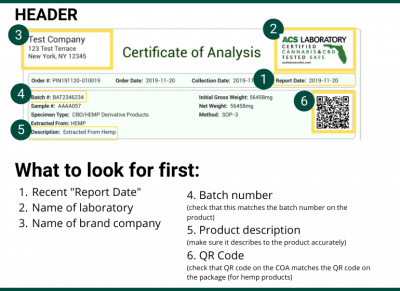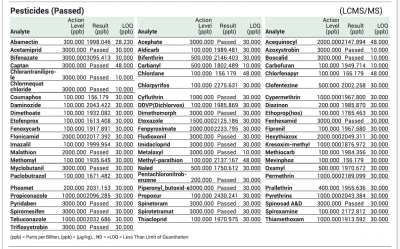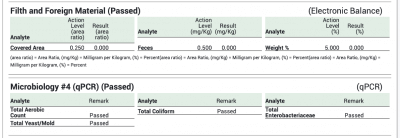Start TestingLaboratory Services




Services
Services
Laboratory Services
Cannabis Testing
Florida MMTCS
Hemp Testing
Nationally + 16 countries
Mushroom Testing
Psilocybin, Functional, Amanita
Kratom Testing
Leaf, Extract, Gummy
In this post:


You may have noticed recent headlines that warn against inaccurate hemp and cannabis product labels. Studies like the one published in The Journal of the American Medical Association (JAMA) show that product labels often miscalculate cannabinoid potency or fail to report the existence of cannabinoids that are present in the products. In a study of 84 hemp labels, JAMA found that nearly 70% either over or under-represented their CBD potency.
Moreover, 18 of the 84 hemp products contained THC. And in some cases, there was enough THC to produce unwanted intoxicating effects.
Unfortunately, JAMA’s study is one of many that show similar findings, which has led to a growing trend of consumer mistrust. That’s why it's so important for reputable hemp and cannabis companies to test with third-party laboratories and publish their Certificate of Analysis for customers to review. It’s also just as important for laboratories like ACS to educate customers about what a COA entails and how to read it to find the most pertinent information.
**Skip to How to Read a COA**
Often the reason for inconsistent labeling is lack of federal and state regulation due to the infant nature of the industry. In other words, brands are launching products with unchecked information and zero transparency.
But don’t get us wrong. Every inaccurate label you see is not the result of maniacal marketing. Some hemp and cannabis companies have good intentions, yet they may accidentally partner with an unreliable laboratory that provides false results.
So what can consumers do to guarantee the safety and quality of a hemp, cannabis or CBD product BEFORE they buy it? Check for a Certificate of Analysis.
**Skip to How to Read a COA**
Fortunately, many legitimate brands are partnering with certified third party laboratories to publish their lab results with a certificate of analysis (COA). A COA is a verified document that provides details about the testing lab, the brand and product question, along with the potency of the ingredients the product contains. In the case of hemp, CBD and cannabis, the ingredients refer to cannabinoids like THC, CBD, CBG and CBN.
COAs may also include terpenes, which are the aromatic ingredients that contribute to the product’s scent, flavor and therapeutic profile. In addition to the potency of ingredients, the COA is vital for consumers to determine whether or not the product is free from harmful contaminants such as heavy metals, pesticides, molds and bacteria.
USDA and State guidelines require that all products be tested. If there is no COA available do not consume or buy the product.
Many companies are starting to print QR codes on the product’s outer packaging, which can be scanned to view the full COA report. Other companies publish COAs online in the product description portion of their website. If the COA is not transparent from one of these sources, consumers should consider contacting the company to request a COA before purchasing the product.

//To be sure the label is accurate and the product is safe//

The header of the COA is important because it contains details that help you trust the legitimacy of the data.
What to Look for First: The first piece of information you’ll want to look at is the Report Date to be sure that the results are recent and relevant. Then you’ll want to confirm that the name of the third-party laboratory is listed prominently so that you can verify the lab’s existence and credentials. Then you’ll want to look for the name of the product’s brand and cross reference it with the brand listed on the product packaging.
The names should match, unless the company contracted another manufacturer to make the product. If that’s the case, you may need to dig a little deeper to confirm that the COA is directly connected to the product in question. Finally, you’ll want to check that the batch number and description in the COA match what you see on the item you’re purchasing.

As a consumer, you may not need to look any further than the summary section of the COA because it provides all the key results at a glance.
What to Look for First: In the example above, you can see that the hemp company tested the potency of all cannabinoids. You can also see that the brand conducted safety testing for contaminants (residual solvents, heavy metals, pathogenic microbiology, etc.) and that it passed every test. The presence of both ingredient and safety information tells you right away that this COA represents a full panel, as opposed to potency testing only.
Immediately below the testing summary, you can see the potency results for the most well-known and therapeutic cannabinoids. As a customer, you probably want to know how much CBD, CBG, CBN, or THC the product contains to deliver the effect you desire. Moreover, if you’re purchasing a hemp product, you want to be sure that it contains less than the legal limit of .3% THC. And you want to be 100% sure at glance.


After the summary, you may want to dive deeper into the COA to discover exactly which cannabinoids and terpenes your product contains and how concentrated they are.
What to Look for First: The Result(mg/g) column tells you how many mgs of each cannabinoid (Analyte) is concentrated within every gram of the product. Note that you may also see results measured in mg/ml if the tested product is a liquid or oil.
You may also see blanks in the Results column, like in the COA above next to THCA-A. A blank result means the laboratory did not detect statistically significant levels of the compound. The % column converts the concentration of each cannabinoid from mg per gram to a percentage of overall weight of the product. This conversion is simply another way to look at the same Result, but is often easier for consumers to understand.
As a customer you can quickly look at the % column above to realize that the product does not contain enough CBC, CBC, CBDV, CBN and CBG to have an effect on your mind or body. On the other hand, you can quickly see that CBD is much more prominent in the product at 18.5%. Finally, you can confirm that it does not contain any detectable levels of THC.
//Residual solvents, heavy metals, mycotoxins, and pesticides//


The sections above show the results of safety testing for harmful contaminants such as residual solvents, heavy metals, mycotoxins and pesticides. The Analytes tested represent the most common toxins in each category--all of which may cause illness, cognitive degradation and in the worst cases death. In the COA example above, the product was tested and confirmed safe on all counts.
What to Look for First: Despite knowing the product passed all safety tests, you may still want to review the results. In this case, you’ll start at the Action Level column, which indicates the safe allowable limits for each analyte. In the ACS Laboratory COA above, the Florida Department of Agriculture and Consumer Services determined the Action Levels that are safe for human consumption.
You may also notice that the Action Level is measured in ppm or ppb. 1 PPM equals 1 mg/kg and 1 PPB equals 1 ug/kg. So if the Action Level is 500 ppm for a toxin, the product can contain 500 mg of the toxin for every kg of product weight (If your brain is starting to hurt, just remember that 500 ppm is a teeny tiny acceptable amount).
Now, let’s move to the Result column, which is the most important part of each safety test section. In the Result column, you’ll notice “<LOQ'' listed next to every analyte. <LOQ translates to “less than the Limit of Quantification,” which means the pesticide, metal, or microbial analyte was confirmed below the safe allowable limit.
As a consumer you want to be sure that every analyte tests below the safe limit before you purchase or ingest the product. Moreover you want to be sure that your product was thoroughly tested for every major contaminant. Look for COAs that test for at least 11 residual solvents, 4 heavy metals, 5 mycotoxins and 61 pesticides.
//Pathogenic microbiology//

Pathogenic microbiology contaminants are the most dangerous substances to ingest. If you accidentally consume the bacteria Listeria Monocytogenes, you will undoubtedly develop a fever, muscle aches, and occasionally gastrointestinal symptoms such as nausea or diarrhea. You are also at risk of the infection spreading to the nervous system, which can cause pain, loss of balance, and seizures.
What to Look for First: Because of how dangerous this analyte is, you want to look at the Result column and confirm that it says “absence.” Any detectable level will warrant a Failed result.

In addition to the header, the footer is an important part of legitimizing the COA. The footer lets you know that the third party laboratory is transparent and accountable to its results. It also tells you more information about who the laboratory is and how to reach them with questions.
What to Look for First: In the footer, make sure you find proof that the laboratory stands by its results. In the example above, you’ll notice that ACS Laboratory’s Head Lab Toxicologist and Principal Scientist both signed off on the COA’s data. You’ll also want to locate the laboratory’s license and credentials to be sure that you can trust the accuracy of its methods and results.
All labs MUST have a license number to be legally compliant. But, not every laboratory needs to have a CLIA No to test hemp and cannabis. If you see a CLIA number on a COA you can rest assured that the lab has undergone rigorous protocols to meet medical-grade laboratory standards.
When cannabis companies engage in third party testing they’re showing that they value quality and customer safety above all else. Moreover, their willingness to publish the COA along with the product shows they are open and honest. During this time of great regulatory uncertainty, customers deserve nothing less than total transparency.

Want to learn more about ACS Laboratory’s COA and testing protocols? Contact us today.